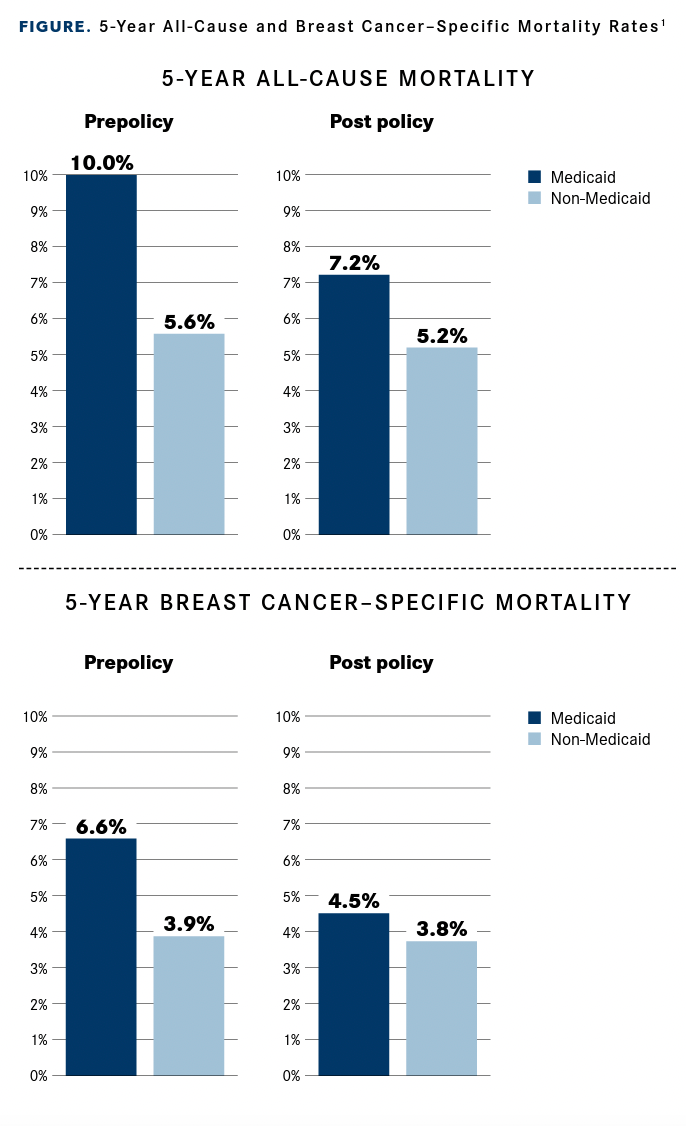Publication
Article
Oncology Live®
Initial Care in High-Volume Facilities Improves Survival for Patients With Breast Cancer
Author(s):
A statewide policy intervention that discouraged initial breast cancer surgical care for patients with Medicaid insurance in low-volume facilities led to a survival benefit.
Ann B. Nattinger, MD, MPH

A statewide policy intervention that discouraged initial breast cancer surgical care for patients with Medicaid insurance in low-volume facilities led to a survival benefit, according to findings from a retrospective study published in the Journal of Clinical Oncology.1
The analysis looked at findings following the implementation of the New York policy in 2009, which denied low-volume centers, defined as completing fewer than 30 breast cancer surgeries per year, reimbursement for breast cancer procedures for women with Medicaid insurance.1-3 Investigators identified more than 37,000 women with stage I to III breast cancer (both with and without Medicaid insurance) and linked them to New York hospital discharge data, the study authors noted. Women who received treatment for breast cancer after the policy was instituted experienced a lower 5-year overall mortality rate compared with those who were treated prepolicy, at 5.5% vs 6.1%, respectively. Further, patients enrolled in Medicaid experienced a greater reduction in breast cancer-specific mortality compared with those who were not (P = .005). The adjusted breast cancer mortality rate for women enrolled in Medicaid decreased from 6.6% to 4.5% following the implantation of the policy; comparatively, this rate fell slightly, from 3.9% to 3.8%, among women not covered by Medicaid after the policy took effect (FIGURE1).

The New York State Medicaid Breast Cancer Selective Contracting policy stipulated that Medicaid enrollees must receive breast cancer surgery at high-volume hospital and ambulatory surgery facilities. “Women with Medicaid insurance experienced significantly greater improvements in all-cause and breast cancer–specific mortality after the implementation of a statewide public policy that discouraged initial surgical treatment of NY Medicaid patients in low-volume facilities,” Ann B. Nattinger, MD, MPH, and colleagues wrote in the findings.1 “The decline in all-cause and breast cancer–specific mortality among Medicaid patients was substantial, even after adjusting for differences in the populations by age, race/ethnicity, tumor characteristics, and comorbidity. The effect was specific to breast cancer mortality and was not observed with other causes of death…. These findings provide strong evidence that the NY policy discouraging initial treatment of Medicaid patients with breast cancer in low-volume hospitals improved 5-year outcomes.”
To conduct their retrospective study, investigators sourced patient data from the New York State Cancer Registry. They limited their analysis to adult women 65 years or younger at the time of breast cancer diagnosis. Eligible patients must have had stage I to III breast cancer during 2004 to 2008 (prepolicy) or 2010 to 2013 (post policy). Patients also needed to be New York residents at the time of diagnosis and have their initial surgery claim be from a New York provider.1
Patients in the Medicaid subgroup (n = 3607) were further divided into those treated prepolicy (n = 1673) and post policy (n = 1934). Most patients in both arms were aged 51 to 64 years (53.26% vs 57.91%, respectively), were non-Hispanic White (60.85% vs 58.69%), had no comorbidities (54.75% vs 51.50%), had tumors sized 2 cm or less (54.39% vs 56.36%), had negative nodal status (53.92% vs 61.17%), and had positive/borderline/unknown hormone receptor status (77.23% vs 78.18%).1
The analysis also included a total of 34,215 patients who were not covered by Medicaid. Similar to patients in the Medicaid group, patients in the prepolicy (n = 19,090) and postpolicy (n = 15,125) arms of the non-Medicaid group were mostly between aged 51 to 64 years (57.90% vs 62.38%, respectively), were non-Hispanic White (86.38% vs 86.26%), had no comorbidities (65.19% vs 54.60%), had tumors sized 2 cm or less (68.83% vs 69.67%), had negative nodal status (64.68% vs 68.32%), and had positive/borderline/ unknown hormone receptor status (81.41% vs 84.16%).
In the non-Medicaid cohort, patients had private insurance (83.2%), insurance not otherwise specified (11.5%), Medicare (3.9%), and no insurance (1.4%). Non-Hispanic Black patients made up approximately 40% of the Medicaid group and approximately 14% of the non-Medicaid group.
The primary study outcome was all-cause mortality at 5 years following a breast cancer diagnosis. Breast cancer mortality at 5 years post diagnosis was the secondary outcome measure.
Additional findings from the study showed that patients with Medicaid experienced higher mortality rates compared with those who were not covered by the program. Prepolicy, the 5-year all-cause mortality rates were 14.4% vs 5.4%, respectively. Post policy, these rates were 10.3% vs 4.9%, respectively.1
Results obtained using the multivariable logit model of 5-year, all-cause mortality showed that patients who were treated in the postpolicy period were slightly less likely to die compared with those treated in the prepolicy period (OR, 0.910; 95% CI, 0.821-1.009; P = .073). The model also found that patients covered by Medicaid were substantially more likely to die than those who were not (OR, 1.980; 95% CI, 1.677-2.338; P < .001). Patients in the Medicaid group experienced a significantly larger survival gain compared with those in the non-Medicaid group, according to the difference-in-differences interaction term between insurance status and time period (OR, 0.745; 95% CI, 0.584-0.951; P = .018).1
Notably, the 5-year adjusted all-cause mortality rate fell from 10.0% to 7.2% from the prepolicy period to the postpolicy period for patients covered by Medicare. Comparatively, patients who were not covered by Medicare experienced a slight decline in 5-year mortality, from 5.6% to 5.2% from prepolicy to post policy.
To confirm their results, investigators identified cohorts of adult women from New Jersey 65 years or younger at the time of breast cancer diagnosis. These patients had similar demographics, but the state did not undergo a policy change like the one enacted in New York. To be included in this confirmatory analysis, patients had to be New Jersey residents at the time of diagnosis, have stage I to III breast cancer during the years 2004 to 2008 or 2010 to 2013, and have available tumor size and node status.1
The analytic cohort totaled 18,793 patients. Patients in the confirmatory analysis had less-favorable tumor characteristics compared with those for patients from New York.
The overall 5-year mortality rate in the confirmatory cohort was 6.2% during the prepolicy time frame compared with 6.0% in the postpolicy time frame. Moreover, the difference-in-differences interaction term was insignificant according to the multivariable logit model of 5-year all-cause mortality, suggesting that there was no difference by time frame between the Medicaid and non-Medicaid groups (P = .230). “The differential improvement post policy in all-cause and breast cancer–specific mortality observed in NY Medicaid patients was not observed in NJ Medicaid patients treated during the same years,” the authors wrote.1
Study authors concluded that their findings add to significant evidence that supports patients with breast cancer should be treated in higher- volume facilities, where they are more likely to achieve better survival outcomes compared with those treated in low-volume facilities.
“Few public policies offer a relatively cost-neutral intervention with such a beneficial effect,” the authors wrote.1 “To date, using reimbursement policies to modify practice and improve quality has met with mixed and, at times, disappointing effects. The policy intervention undertaken by [New York] provides a viable template for implementation by other state Medicaid programs, at least in areas with reasonable proximity to high-volume facilities. Policy efforts to encourage centralization might even spur investments in high-quality breast cancer care by hospitals with moderate volumes, which could anticipate a greater patient load under a centralization policy.”
Investigators cited 2016 study results that showed that in the US nearly 38% of patients were treated at a low-volume hospital, defined as seeing fewer than 68 breast cancer cases on average per year, or approximately 1 patient per week.4
“For breast cancer, the initial treatment plan is the most critical to long-term survival, as cures are rare once disease recurs. Arguably, initial treatment for breast cancer remains too decentralized in the United States, with many low-volume facilities still providing initial breast cancer care,” they added.
Finally, the study did not generate any new evidence for fewer Medicaid patients undergoing surgery under a centralization policy; 86% of Medicaid patients in the underlying cohort underwent surgery post policy vs 86.6% prepolicy. However, investigators noted that follow-up care could potentially be fragmented between the high-volume initial treatment facility and the local facility providing follow-up care, and that caution should be taken in applying their findings to rarer malignancies such as esophageal and pancreatic cancer because of lower percentage of hospitals that meet surgical volume thresholds.1
References
- Nattinger AB, Bickell NA, Schymura MJ, et al. Centralization of initial care and improved survival of poor patients with breast cancer. J Clin Oncol. 2023;41(11):2067-2075. doi:10.1200/JCO.22.02012
- Proj A, Wagner VL, Matson JM, Roohan PJ. Impact of New York State’s Medicaid Breast Cancer Selective Contracting Policy on access and quality of care outcomes. Am J Med Qual. 2022;37(2):127-136. doi:10.1097/01.JMQ.0000754764.18381.17
- Unrestricted and restricted breast cancer surgery facilities for Medicaid recipients. New York State. Updated March 2023. Accessed March 30, 2023. on.ny.gov/3K0meOf
- Yen TWF, Pezzin LE, Li J, Sparapani R, Laud PW, Nattinger AB. Effect of hospital volume on processes of breast cancer care: a National Cancer Data Base study. Cancer. 2017;123(6):957-966. doi:10.1002/cncr.30413










